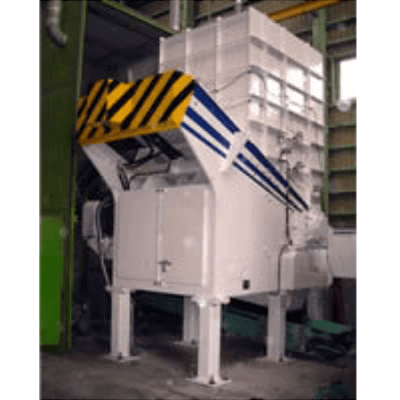What Is a Uniaxial Crusher?

An uniaxial crusher is a machine that rotates a shaft with multiple blades and crushes the object between the fixed blades.
A screen is placed where the crushed material is discharged, and the material that meets the required particle size conditions is discharged, while the material that does not meet the conditions is returned and crushed again. It is possible to adjust the particle size of the crushed material.
The amount of material that can be processed per unit of time is inferior to that of twin-shaft crushers. Uniaxial crushers are often used for crushing plastics, wood, and paper.
Uses of Uniaxial Crushers
Uniaxial crushers can be used for a variety of objects that need to be reduced to a fine grain size and are primarily used to recycle scrap wood and industrial waste. Examples include flexible container bags, paper, clothing, fishing nets, bedding, and other difficult-to-process materials, wood, tires, film, molded plastic products, automobile bumpers, and bamboo.
In selecting a crusher, it is important to consider the material of the object and the amount of material to be processed. There are crushers for dumplings, which refer to crushers for resin dumplings generated at resin molding plants. They are used for crushing resin dumplings, molded products, films, etc.
Principle of Uniaxial Crushers
Uniaxial crushers consist of a fixed blade, multiple rotating blades on a shaft attached to the main body, a pusher, and a screen. The rotating blades make a rotary motion to shave off the object for fine crushing processing.
In addition, by pressing the object to be crushed against the rotating blades with pushers, more efficient crushing is possible. The pusher uses hydraulic or pneumatic pressure to push the object.
By installing a screen with holes of a certain size at the outlet of the crushed object, only those that meet the requirements can be discharged. The crushing is then repeated until the required size is reached. Screens with a diameter of about 20 to 70 mm are often used.
The size after crushing is determined by the width of the blades and the distance between the hooks with the blades attached, which is convenient for mass processing and coarse crushing.
Other Information About Uniaxial Crushers
1. Advantages of Uniaxial Crushers
Easy Blade Replacement
Uniaxial crushers are divided into a rotating blade and a stationary blade, and the blades can be replaced relatively easily. In addition, the gap between the blades can be adjusted to maintain a throughput similar to that of a new blade.
Long Blade Life
Both fixed and rotary blades are made of special steel carbide blades with excellent wear resistance and toughness, resulting in a long service life. It is advantageous in terms of maintenance cost as it takes longer time to replace the blades.
Uniform Particle Size of Crushed Material Can Be Achieved
The screen makes the particle size of crushed materials uniform. The discharge size can be changed simply by replacing the screen, which reduces the volume of crushed material to the targeted particle size.
Crushing is possible down to a minimum size of 10 mm. One of the advantages of this machine is that it can crush materials from a large size to a predetermined size with a single machine.
Increased Work Efficiency
A pushing device called a pusher makes it possible to crush soft materials that are difficult to bite into, thus increasing work efficiency.
Remote Monitoring Is Possible
The operating conditions of the crusher can be monitored remotely. Settings can be changed to optimal operating conditions, and abnormalities can be identified at an early stage. In the event of an abnormality, the manufacturer is notified, and the situation can be assessed and analyzed for prompt support.
2. Disadvantages of Uniaxial Crushers
- Noise during crushing is loud. (approx. 80 to 100 dB (A))
- The frequency of blade replacement increases the cost of maintenance.
- High-speed rotation makes it vulnerable to hard foreign objects, such as metals.
3. Difference Between Uniaxial Crushers and Biaxial Crushers
There are many types of crushers, including uniaxial crushers, biaxial crushers, wet crushers, hammer crushers, and chain crushers. The differences between uniaxial crushers and biaxial crushers are as follows.
Uniaxial crushers use rotating and fixed blades to shred the object. Since the material is discharged through a screen, the granularity of the crushed material can be kept constant. They are suitable for crushing large objects and soft, difficult-to-process materials.
On the other hand, the biaxial crusher uses two rotating blades to shred objects, as if cutting them with scissors. The crushed material is cut into strips, much like a shredder in an office, and the crushing is coarser than with uniaxial crushers.
The width of the blade and the distance between the hooks with the blade attached determine the size after crushing. Therefore, it is suitable for high-volume processing and coarse crushing. The throughput per hour is higher than that of the uniaxial type.